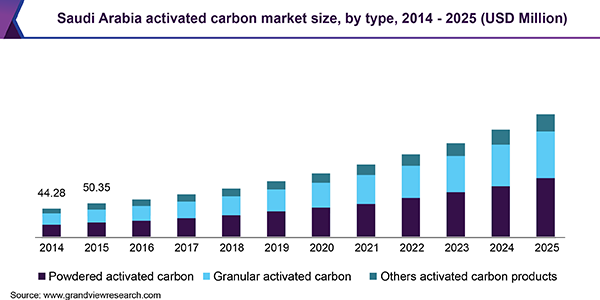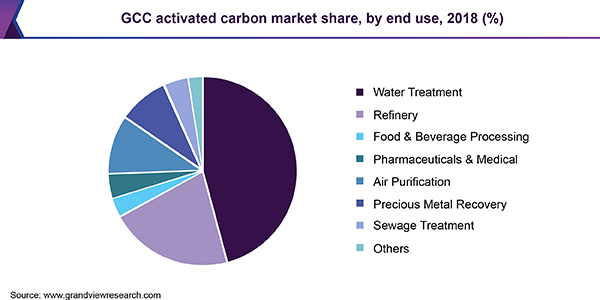- Home
- »
- Advanced Interior Materials
- »
-
Gulf Cooperation Council Activated Carbon Market Size Report, 2025GVR Report cover
![Gulf Cooperation Council Activated Carbon Market Size, Share & Trends Report]()
Gulf Cooperation Council Activated Carbon Market Size, Share & Trends Analysis Report By Type (Powdered, Granular), By Application (Liquid, Gas), By End Use (Water Treatment, Pharma & Medical), And Segment Forecasts, 2019 - 2025
- Report ID: GVR-1-68038-004-0
- Number of Report Pages: 226
- Format: PDF, Horizon Databook
- Historical Range: 2014 - 2017
- Forecast Period: 2019 - 2025
- Industry: Advanced Materials
Industry Insights
The Gulf Cooperation Council activated carbon market size was estimated at USD 148.7 million in 2018 and is projected to expand further at a CAGR of 13.6% over the forecast period. Activated carbons are widely used as adsorbents in applications, such as water purification, separation, decolorization, and deodorization of vegetable oils and fats, pollution treatment, air & gas purification, and food & pharmaceuticals.
After the adsorption process, the adsorbent can be regenerated or disposed-off. However, there is a huge amount of risk associated with exposing the spent adsorbent as it accumulates heat, which poses risk for human health and environmental degradation. The Gulf Cooperation Council (GCC) countries have been trying to decrease emission levels by employing Powdered Activated Carbon (PAC) products for effective gas treatment. Initiatives by government and private organizations to control pollution are anticipated to boost the market growth during the forecast period.

In 2013, the Ministry of Municipal and Rural Affairs, along with SABIC, recommended the ministry to establish a joint-stock company for recycling and treatment of solid waste in Saudi Arabia. Water scarcity is a predominant problem in the Kingdom of Saudi Arabia. A growing number of water and wastewater treatment plants are projected to drive product demand over the forecast period. Furthermore, concerns regarding contaminated drinking water will benefit market growth.
Virgin activated carbons are costlier and can cause environmental problems after being disposed-off. Thus, reactivation or regeneration techniques have become mandatory for the effective reuse of the spent activated carbon. These are known to be more effective than any other water purification compounds.
Regulatory norms in developed countries regarding mercury emissions, such as Clean Air Mercury Rule, from the U.S. Environmental Protection Agency (EPA), are projected to complement the demand for Granular Activated Carbon (GAC). They reduce the emission levels of foul-smelling compounds, which is anticipated to surge the product demand in indoor air regulatory systems.
Type Insights
Based on type, the GCC activated carbon market can be segmented into PAC, GAC, and others. Powdered products led the market in 2018. A growing number of water and wastewater treatment plants are expected to drive the demand for PAC over the coming years. The GAC segment is anticipated to witness significant growth over the forecast period. GAC is cheaper and is widely used in thermal & chemical regeneration techniques. It helps in reducing the emission of foul-smelling compounds too, which drives its demand in air regulatory systems. Some of the GAC products include extruded activated carbon and polymer-coated and impregnated carbons.
Application Insights
Liquid phase application led the market in 2018 and will expand further at a CAGR of 12.6% over the forecast period. The liquid phase is expected to be the fastest-growing segment. It is used to produce GAC to remove contaminants from groundwater through an adsorption treatment. These contaminants often consist of explosives, metals, and other Volatile Organic Compounds (VOCs).
All the processed or used carbon eventually needs to be regenerated or disposed of in landfills. Although activated carbon is a well-established technology there are a few regeneration facilities available for removing organic compounds. However, its use is restrained by its difficulty of regeneration, use in the inorganic contaminants elimination process, and high cost of disposal. Moreover, the presence of iron compounds may promote the fouling of the carbon thus, hindering segment growth.
Industry players are striving to integrate technological innovations and product development to expand their presence in the regional market. Evoqua Water Technologies LLC designed the Aqua-Scrub® Carbon Adsorbers to deliver uniform water flow for effective treatment and to ensure efficient usage of activated carbon. It is widely used several applications like in groundwater remediation, dichlorination, pilot testing, wastewater filtration, leachate treatment, and spill cleanup. Vapor-phase GAC is an air contaminant treatment technology that attracts and adsorbs organic and inorganic molecules as well as certain metal elements.
End-Use Insights
End-use industries include water treatment, refinery, food & beverage processing, pharmaceuticals & medical, air purification, precious metal recovery, sewage treatment, and others. The water treatment application will witness the fastest CAGR of 14.3% during the forecast period.
Government norms and stringent regulations are forecast to benefit market demand. To provide high packaged food quality, activated carbons are used to make food processes contaminant free. Gulf Cooperation Council countries which commonly include Saudi Arabia, Kuwait, Bahrain, UAE, Qatar, and Oman has a lot of refineries in their respective countries, thus supporting market growth.

Saudi Arabia majorly suffers from water scarcity and pollution problems and thus, activated carbon is used to recycle the wastewater released from various industries and agricultural sectors. The growing wastewater treatment and purification procedures in GCC countries have propelled water treatment end-user segments to emerge as the largest and fastest-growing market.
Cabot Norit Corporation (CNC)is a major player in the activated carbon market with the development, research, manufacturing, and sale of high-grade products used in numerous environmental, health, safety, and industrial applications. Cabot Corporation offers reactivation services from which recycled activated carbon can be obtained for usage in potable water, wastewater, and chemicals market.
Regional Insights
GCC countries are facing tremendous water scarcity problems owing to the increasing population coupled with rising urbanization & economic activities. Activated carbon is one of the most efficient media for removing contaminants from municipal and industrial wastewater, landfill leachate, and contaminated groundwater. The increasing use of water for industrial processes has surged the need for water treatments, thus, boosting the demand for water and wastewater purification processes.
Saudi Arabia is the most dominant country and is expected to register a significant CAGR during the forecast period. Rising concern regarding clean water utilization is anticipated to surge demand for activated carbon in this country. The kingdom of Saudi Arabia imports activated carbon at a very high cost to meet its increasing demand. For instance, dry coconuts are exported to Gulf countries from India and the Philippines to manufacture activated carbon.
Activated carbon is produced by chemical activation in Saudi Arabia from date palm trees. Such a raw material source is expensive and has a higher economic value. Moreover, Saudi Arabia produces date palm wastes in a much larger form than any other gulf cooperation council countries.
Gulf Cooperation Council Activated Carbon Market Share Insights
The market is highly consolidated in nature, thus posing a major barrier for new companies to enter the market. Raw material supply is less as compared to the corresponding demand, which is further restricting the entry of new companies. However, the development of cost-effective activated carbon regeneration techniques like thermal regeneration is opening up new opportunities for market expansion. Some of the major market players are CECA, Donau Chemie Group, Haycarb PLC, Jacobi Carbons, Kuraray, Calgon, MeadWestvaco Corp., Veolia Water SA, Siemens Water Technologies, and Osaka Gas Chemicals Co., Ltd.
Growing demand for metal refining in the Gulf countries, the formation of regulatory norms like the Saudi Biochar Initiative, along with increasing awareness regarding water and air pollution is driving growth. The market value chain consists of raw material producers, activated carbon manufacturers, suppliers, and end-use industries. The industry is characterized by a high level of integration between raw material providers and manufacturers.
Report Scope
Attribute
Details
The base year for estimation
2018
Actual estimates/Historical data
2014 - 2017
Forecast period
2019 - 2025
Market representation
Revenue in USD Million and CAGR from 2019 to 2025
Country scope
Saudi Arabia, Kuwait, UAE, Qatar, Bahrain, and Oman
Report coverage
Revenue forecast, competitive landscape, growth factors and trends
15% free customization scope (equivalent to 5 analyst working days)
If you need specific information, which is not currently within the scope of the report, we will provide it to you as a part of customization
Segments Covered in the ReportThis report forecasts revenue and volume growth at regional and country levels and provides an analysis of the latest industry trends in each of the sub-segments from 2014 to 2025. For this study, Grand View Research has segmented the Gulf Cooperation Council activated carbon market report based on type, application, end-use, and country:
-
Type Outlook (Revenue, USD Million, 2014 - 2025)
-
Powdered
-
Granular
-
Other
-
-
Application Outlook (Revenue, USD Million, 2014 - 2025)
-
Liquid Phase
-
Gas Phase
-
-
End-Use Outlook (Revenue, USD Million, 2014 - 2025)
-
Water Treatment
-
Refinery
-
Food & Beverage Processing
-
Pharmaceuticals & Medical
-
Air Purification
-
Precious Metal Recovery
-
Sewage Treatment
-
Others
-
-
Country Outlook (Revenue, USD Million, 2014 - 2025)
-
Saudi Arabia
-
Kuwait
-
UAE
-
Qatar
-
Bahrain
-
Oman
-
Share this report with your colleague or friend.
![gvr icn]()
NEED A CUSTOM REPORT?
We can customize every report - free of charge - including purchasing stand-alone sections or country-level reports, as well as offer affordable discounts for start-ups & universities. Contact us now
![Certified Icon]()
We are GDPR and CCPA compliant! Your transaction & personal information is safe and secure. For more details, please read our privacy policy.
We are committed towards customer satisfaction, and quality service.
"The quality of research they have done for us has been excellent."





